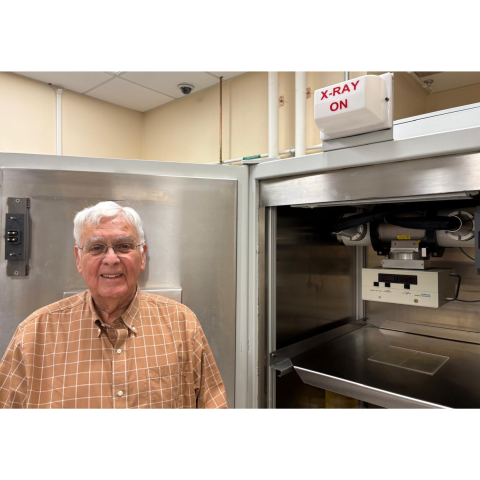
James (Jim) B. Mitchell, Ph.D., with an x-ray machine in the lab.
James (Jim) B. Mitchell, Ph.D., is a radiation biologist whose research focuses on evaluation of agents in combination with radiation that either enhance tumor sensitivity or protect normal tissues. His work has been vital for physicians and researchers to understand how to safely treat cancer with radiation therapy. After nearly 50 years at the NCI, Mitchell has announced his retirement.
Mitchell is originally from Tennessee. He completed his bachelor’s degree at Austin Peay State University and master’s degree at George Peabody College, both in Tennessee. He then went on to receive his Ph.D. from Colorado State University in cellular radiation biology in 1978. Here, Mitchell’s earliest work on dose-rate effects of radiation-induced cell killing fulfilled a need for physicians to understand the sensitivity of human tumor cells to a variety of novel agents. His work was centered on the radiobiology of low-dose radiation and differences in the cellular response to low-dose versus high-dose radiation. Eventually, he observed that over a finite range of low dose rates, cells become stuck in the G2 phase of the cell cycle, a highly radiosensitive phase, leading to increased cell death at lower radiation levels. The phenomenon is known as “inverse dose rate effect,” and is extremely relevant to modern day brachytherapy (localized radiation therapy). Mitchell went on to spearhead efforts related to establishing dosage safety and administration schedules for radiation treatments. Many of these are still being employed in the clinic to treat patients today.
Shortly after earning his Ph.D., Mitchell joined the NCI in the Radiation Oncology Branch and became a Principal Investigator in 1984. He eventually came to serve as branch chief of the Radiation Biology Branch for over 30 years. His laboratory was the first to identify nitroxides as catalytic antioxidants with protective properties against radiation damage. He uncovered the potential role of these molecules in delaying the onset of cancer in rodent systems with implications to aging. Mitchell was involved in developing photodynamic therapy for clinical cancer treatment at NCI, a program still active at the University of Pennsylvania. Recently, he published a study demonstrating that mice exposed to total body radiation of 3 Gy and rapamycin placed in their food after radiation results in less carcinogenesis.
“Dr. Mitchell has a strong track record of having multiple lab findings implemented in the clinic to improve the efficacy of radiotherapy in treating tumors as well as protection of normal tissue during radiotherapy,” says Murali Krishna Cherukuri, Ph.D., Senior Investigator in the Radiation Biology Branch. “More than three decades ago, he recognized the importance of tumor microenvironment in the outcomes of cancer treatment and the critical need of molecular imaging techniques to profile the tumor physiology and metabolic status. His involvement in this field made the CCR Radiation Biology Branch one of a small group of labs in the world with unique pre-clinical imaging capabilities, some of which have been translated to clinic.”
Mitchell has been a member of the American Society for Therapeutic Radiology and Oncology (ASTRO) and the American Association for Cancer Research (AACR) for almost 40 years. He is also a member of the Radiation Research Society (RRS). He has served ASTRO on the Scientific Committee and as vice chair of the Radiation Biology Committee. He has been president of the Oxygen Club of Greater Washington, a member of the NIH Radiation Study Section and has served on a number of editorial boards, including Seminars in Radiation Oncology, Radiation Research and Cancer Research.
Over the course of his career, Mitchell has received numerous research awards, including the RRS Research Award in 1989, President of the RRS in 2001, the RRS Failla Award-Gold Medal, the ASTRO Gold Medal Award in 2015, and multiple NIH Merit Awards. Lastly, Mitchell and his colleague John A. Cook, Ph.D., Staff Scientist, taught a full 30-hour radiation biology course to residents in the Radiation Oncology Branch. At the end of the course, they received a one-hour oral exam test. This was conducted from 1980 to 2020 for 95 residents.
“Dr. Mitchell is a true legend in the field of radiobiology,” says Deborah E. Citrin, M.D., Senior Investigator in the Radiation Oncology Branch and longtime colleague of Mitchell. “During his 46 years at NCI he has made a number of impactful discoveries and described a number of methods to modify radiation response in tumor and normal tissues.”
“Beyond the scientific accolades and countless honors and awards, Dr. Mitchell is one of the most caring and dedicated mentors I have ever met,” she adds. “During his tenure at NIH, he has taught countless radiation oncology residents, trainees and junior faculty, including many who have gone on to run their own labs, chair departments, and serve as leaders of hospitals and scientific organizations. His career and contributions have been nothing short of remarkable.”
A full list of his publications can be found here.
Dr. James Mitchell will retire from CCR on May 31, 2025, but will remain as an NIH Scientist Emeritus.